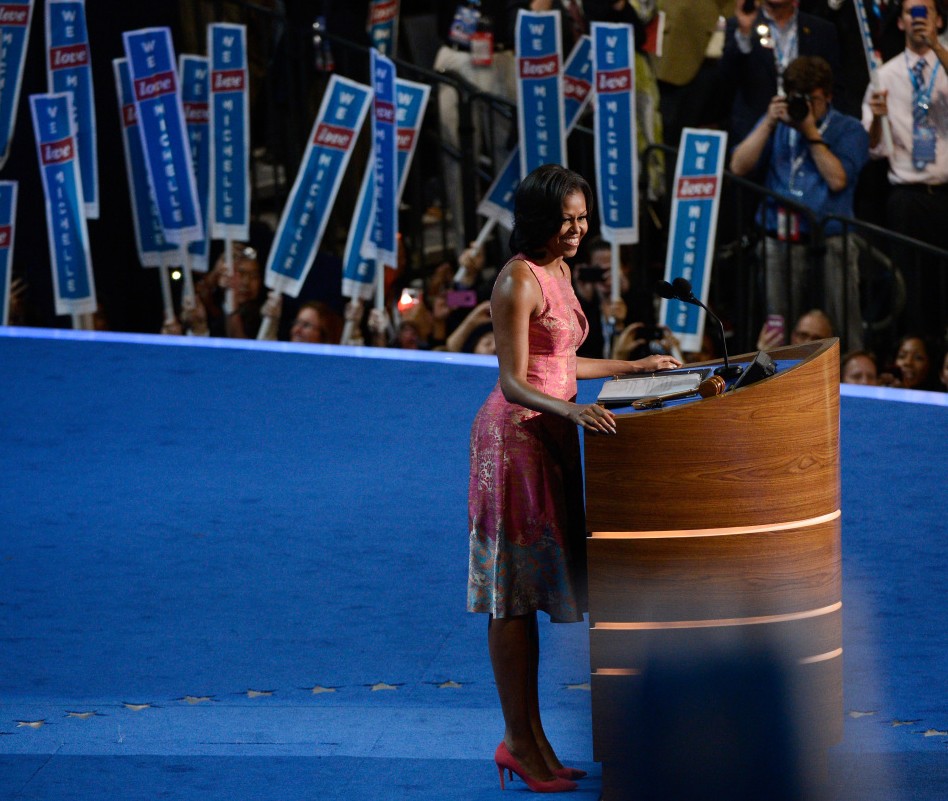
Michelle Obama delivers her 2012 convention speech.
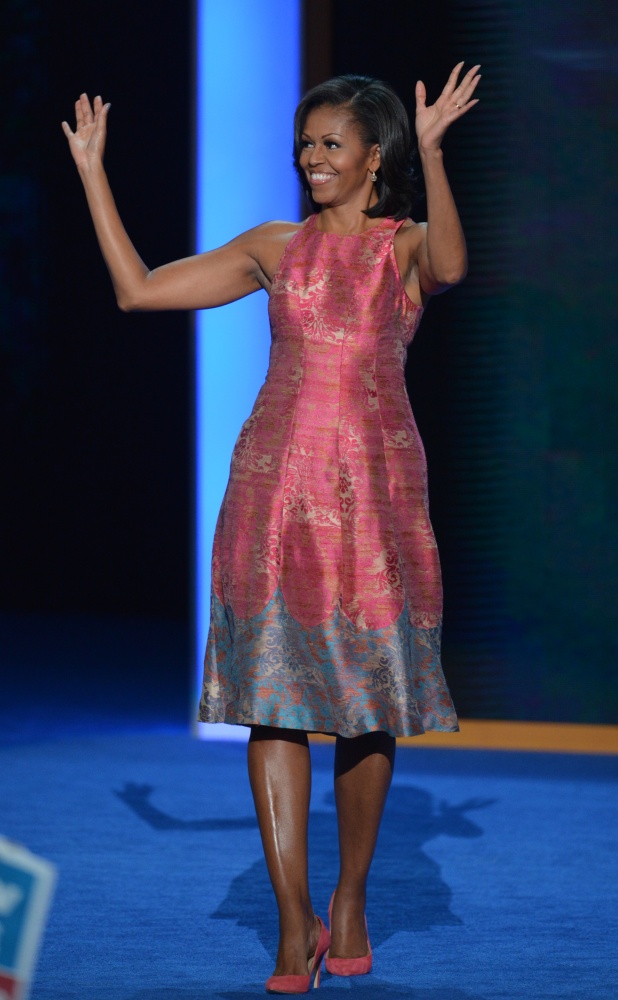
Mrs. Obama coming onstage to deliver her 2012 speech.
Yesterday, First Lady Michelle Obama delivered the keynote speech at the 2012 Democratic National Convention, set to nominate her husband President Barack Obama for a second term.
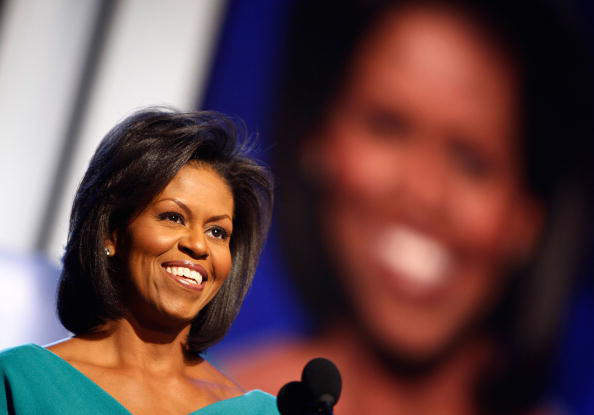
Michelle Obama speaking at the 2008 convention.
Stirring, emotional yet tacked by details of her own life and her husband’s as a way of illustrating the character of the President she hoped to convey, as well as a reflection on her first term as First Lady, it was naturally different in tone and detail from her first appearance, at the 2008 convention.
Four yeas later, the nation now being so familiar with her that she carries the cachet of her own public identity by her first name, a sure sign of American celebrity status.
Here s a video excerpt of her speech:
Interestingly, her speech was also preceded by a short documentary biography of the First Lady. Here is that film:
Mrs. Obama’s short bio film was only the second one ever produced and shown at a convention. The first such film was done on Pat Nixon who was the first of the post-war First Ladies to address the convention. That film is shown in this article, further below.
Mrs. Obama’s 2008 speech, however, was a departure from the typical ones made by those women who were not yet First Lady in that she introduced elements of her own biography, in the context of her husband’s. However subtle this may be, it proved so highly successful that it was, in fact, a blueprint followed by Ann Romney last week.
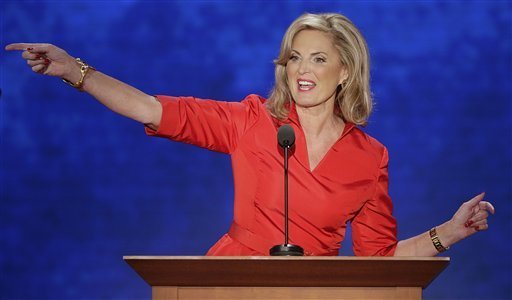
Ann Romney speaking at the 2012 Republican National Convention.
In her speech at last week’s Republican Convention, Ann Romney, wife of presidential candidate Mitt Romney, became only the eighth such spouse to address the delegates in the auditorium, and the nation on prime-time television.
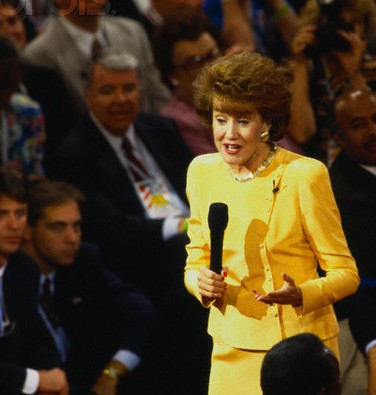
Elizabeth Dole’s unconventional convention speech.
The first to do so was the 1996 Republican presidential candidate’s spouse Elizabeth Dole – who took a talk-show host tactic, strolling among the delegates while miked up and highlighting points from her husband Bob Dole’s biography.

Laura Bush got a good one-liner in her 2000 speech to the Republican National Convention about being a teacher her husband came home to each night.
In 2000, both the Republican and Democratic presidential candidates’ spouses, Laura Bush and Tipper Gore followed suit; when the former cracked that her husband came home to sleep with a librarian every night, some critics thought it a subtle reference to the Clinton Administration Lewinsky scandal. In 2004, another First Lady-hopeful, Teresa Heinz Kerry, wife of that year’s Democratic presidential nominee, also spoke from the podium but not in a major address. During the last presidential election, both the Democratic and Republican presidential candidates’ spouses, Michelle Obama and Cindy McCain also delivered speeches.
The most popular incumbent First Lady in her century became the first to be evoked at the Democratic National Convention which re-nominated her husband for a second term as President.

Frances Cleveland.
Held one-hundred twenty-four years ago, it was a time when presidential candidates considered it undignified to appear at the conventions which nominated them – let alone have their wives appear. The presence of the woman in question, the 23-year old Frances Cleveland who’d two years earlier become the only First Lady to marry in the White House, was not in person but in name – yet she served as a significant political symbol.
The ravishing bride of the White House had proven so popular throughout the country that the Republicans feared she would be used as a “secret weapon” in her husband’s re-election campaign. She’d certainly been used well already to help sell all sorts of commercial products, her image appropriated on soap, greeting cards, ashtrays and other household items..
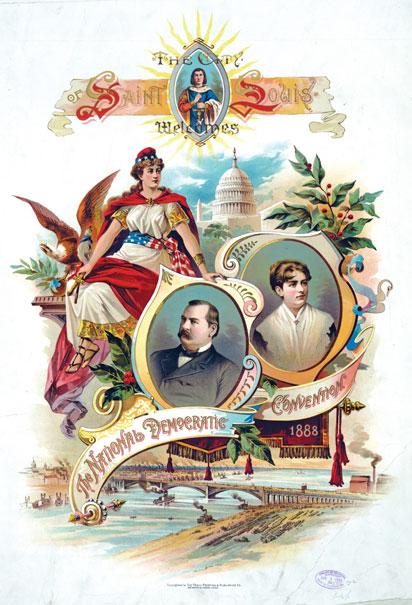
The First Lady joined the President on the cover of the Democratic National Convention 1888 program booklet.
Although President Cleveland specifically forbid any appropriation of his wife’s name or image on campaign items, state and regional Democratic organizations printed posters using her face and formed “Frances Cleveland clubs” of women party volunteers, to capitalize on her popularity and ride local candidates on her coattails. When she was seen being escorted to the theater by a male friend, rumors soon began that the President had jealously refused to permit her return entry into the White House – and the false story was repeated by a Republican national committee member in an after-dinner speech with the added gossip that Cleveland had “struck his wife” when she was finally permitted in.
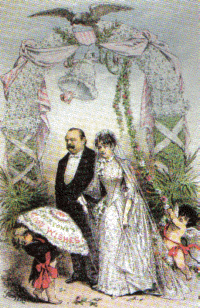
The nation felt it had a right to know everything about White House bride Frances Cleveland – and use her image on advertisements or in cartoons.
At the 1888 Democratic Convention which would re-nominate Cleveland, supporters of those seeking to replace him with another Democrat, circulated a crudely-printed pamphlet anonymously quoted an unnamed U.S. Senator who had reputedly witnessed the President hit his wife. It finally led to the unprecedented act of one speaker at the convention warning delegates from the podium that the pamphlet was an outright lie created to undermine Cleveland’s candidacy, and detailing the wonderful qualities of the First Lady from the podium, which “elicted such rounds of applause that men lost their heads.”

Mrs. Cleveland was used on advertising cards; her husband didn’t want her also exploited politically.
And while President Cleveland always claimed he had fought against political exploitation of his wife’s popularity, even towards his own renomination, it seems hard to believe that he wasn’t told ahead of time about the fact that along with his image, the face of Frances Cleveland also graced the cover of the Democratic National Convention program.
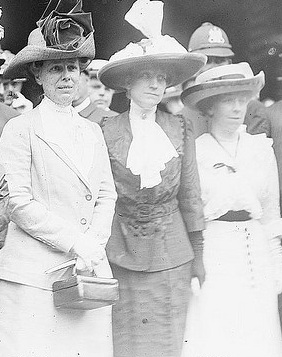
First Lady Nellie Taft (far left) shocked Democrats by appearing in Baltimore to attend their party’s 1912 convention.
In 1912, Nellie Taft became the first incumbent First Lady to attend a national convention.
What made this move further unprecedented and still unbroken was the fact that the convention she attended was not the one which nominated her husband but rather that of his Democratic opponent Woodrow Wilson.
She arrived by train from Washington in Baltimore in the late afternoon, taking a prominent front-row seat which directly faced the speaker’s podium.
A formidable and overtly political woman who supported women’s suffrage, Mrs. Taft knew that the fiery speaker William Jennings Bryan had planned to eviscerate her husband’s Administration – and that her staring at him directly on stage would mitigate his words.
She was right.

The presence of Republican First Lady Nellie Taft front and center intimidated speaker William Jennings Bryan from harshly criticizing her husband at the 1912 Democratic convention.
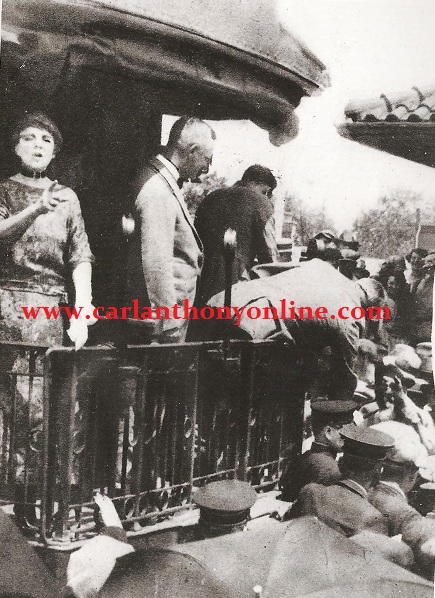
Florence Harding often gave impromptu speeches to the public, as seen here at far left during a western whistlestop trip and talked politics with authority to reporters, as she did at the 1920 convention.
Although she made no formal speech or remarks to the delegates of the Chicago 1920 Republican National Convention, Florence Harding was the first presidential candidate’s wife to initiate the custom of “humanizing” her husband for the public, doing so by speaking at length for attribution to the national media. In the long, wide hallway of the convention hall, as well as her husband’s campaign headquarters at the Hotel LaSalle, she openly engaged the male political reporters covering the deadlocked convention with remarks that, for all intents and purposes, served as the blueprint for candidates’ spouse convention speeches many generations in the future: “…We haven’t any children. I wish we had. The Senator plays with every chilled he meets….Don’t say anything about me, but tell everyone what a wonderful man my husband is.”
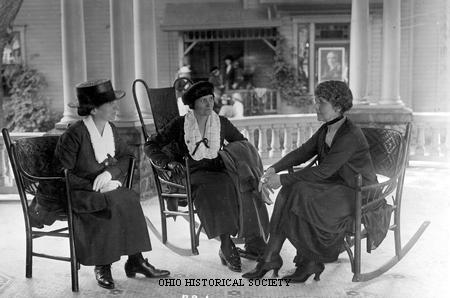
Florence Harding (far right) speaking to new women voters during the 1920 presidential campaign.
The New York Times stated that her overt public remarks during the convention were unprecedented, saying she was the “only candidate’s wife who came more than halfway to meet newspaper reporters.” She also made predictions of how delegate votes would trend with each succeeding ballot and provided a ruthless assessment of Harding’s two leading opponents, Hiram Johnson and Leonard Wood. More shocking than any remark she made, however, was a prediction that her husband might die in office if he was elected: “I can see but one word written over the head of my husband, if he is elected, and that word is ‘tragedy.’”
Two months later, it was learned that her astrologer predicted that if Harding won the nomination he would win the presidency – but die by “sudden, violent, peculiar death by poison.” Within three years, of course, President Harding would die suddenly.

First Lady Eleanor Roosevelt addressing the 1940 Democratic National Convention, the first to do so.
Perhaps the most historic and important of all the convention appearances and speeches by a candidate’s spouse, be she an incumbent First Lady or not, was the entirely spontaneous appearance of Eleanor Roosevelt at the 1940 Democratic National Convention in Chicago, culminating a dramatically unpredictable day for the unflappable First Lady Eleanor Roosevelt.
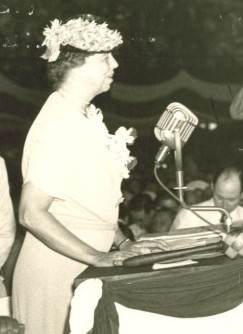
Eleanor Roosevelt delivering her 1940 convention speech.
It had begun quietly, as she sat knitting peacefully at the family estate in Hyde Park, New York, as she listened to the morning proceedings of the convention nominating Franklin D. Roosevelt for an unprecedented third term. The phone rang. It was the President with reports of delegates threatening to withdraw their support for him in protest to his controversial choice of liberal Henry Wallace as his new running-mate. Franklin needed Eleanor to intercede. A small plane was hired, she put down her knitting, sped out to the local airfield, flew to New York, and then on to Chicago. During the flight, she fulfilled a lifelong dream of piloting a plane, permitted to take control and fly for a brief moment.
At the airport there she was met by a waiting car which took her directly to the convention. Word went out as she appeared in the auditorium and the scheduled slate of speakers was truncated as she approached the podium. Just before she got there, Chicago Mayor Ed Kelley spoke with her – leaving his guests who happened to be local radio actress Edie Davis and her Smith College student daughter Nancy.
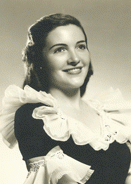
Nancy Davis watched Mrs. Roosevelt deliver her 1940 speech – and did likewise as Mrs. Reagan in 1984.
In a twist of fate, it was as Mrs. Ronald Reagan forty-four years later that Nancy would become only the third incumbent First Lady to address a convention nominating her husband for another term as President.
Mrs. Roosevelt’s spontaneous remarks referenced the war in Europe and the necessity of war-preparedness in the United States. Here is the full transcript:
Delegates to the convention, visitors, friends: It is a great pleasure for me to be here and to have an opportunity to say a word to you. First of all, I think I want to say a word to our National Chairman, James A. Farley. For many years I have worked under Jim Farley and with Jim Farley, and I think nobody could appreciate more what he has done for the party, what he has given in work and loyalty. And I want to give him here my thanks and devotion.
And now, I think that I should say to you that I cannot possibly bring you a message from the President because he will give you his own message. But, as I am here, I want you to know that no one could not be conscious of the confidence which you have expressed in him. I know and you know that any man who is in an office of great responsibility today faces a heavier responsibility, perhaps, than any man has ever faced before in this country. Therefore, to be a candidate of either great political party is a very serious and solemn thing.
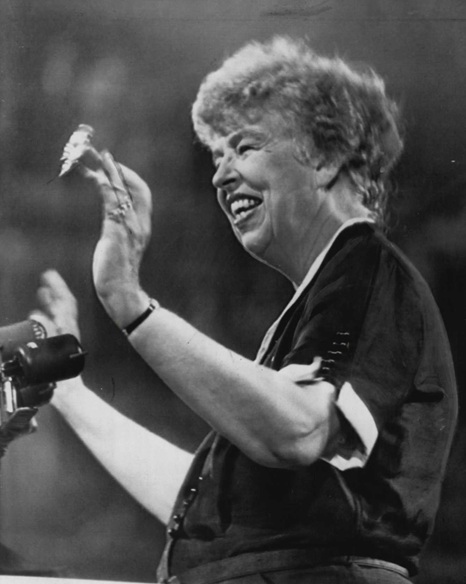
Eleanor Roosevelt at the 1952 Democratic National Convention.
You cannot treat it as you would treat an ordinary nomination in an ordinary time. We people in the United States have got to realize today that we face a grave and serious situation. Therefore, this year the candidate who is the President of the United States cannot make a campaign in the usual sense of the word. He must be on his job. So each and every one of you who give him this responsibility, in giving it to him assume for yourselves a very grave responsibility because you will make the campaign. You will have to rise above considerations which are narrow and partisan.

Eleanor Roosevelt speaking at the 1956 Democratic National Convention.
You must know that this is the time when all good men and women give every bit of service and strength to their country that they have to give. This is the time when it is the United States that we fight for, the domestic policies that we have established as a party that we must believe in, that we must carry forward, and in the world we have a position of great responsibility. We cannot tell from day to day what may come. This is no ordinary time. No time for weighing anything except what we can do best for the country as a whole, and that responsibility rests on each and every one of us as individuals. No man who is a candidate or who is President can carry this situation alone.
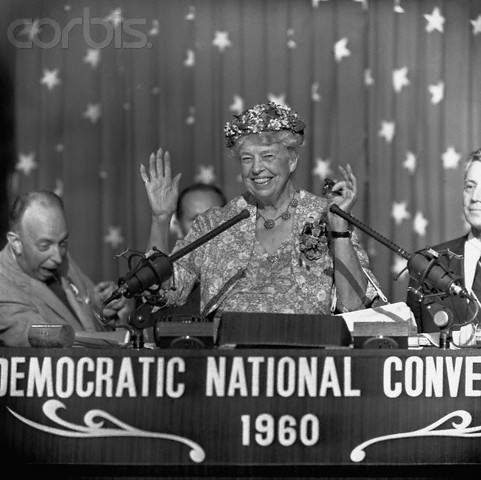
And at the 1960 convention, two years before Eleanor Roosevelt died.
This is only carried by a united people who love their country and who will live for it to the fullest of their ability, with the highest ideals, with a determination that their party shall be absolutely devoted to the good of the nation as a whole and to doing what this country can to bring the world to a safer and happier condition.
Her success in unifying the delegates behind both F.D.R. and Wallace led to one newspaper headline the next morning declaring, “Mrs. Roosevelt Stills the Tumult of 50,000.”
Remaining a powerful political figure within the party after the President’s death, Eleanor Roosevelt also became the first former First Lady to address national political conventions, speaking at the 1948, 1956 and 1960 Democratic National Conventions.
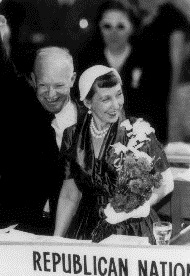
In 1952, Mamie Eisenhower became the first candidate’s wife to appear at the podium of a presidential convention with her husband.
At the 1952 Republican National Convention, Mamie Eisenhower became the first candidate’s spouse to appear before delegates on the podium alongside the nominated candidate on his first appearance there before them. The crowd reaction was so great that throughout the campaign, whenever he appeared before voters throughout the campaign, there were crowd calls for “Where’s Mamie?!”
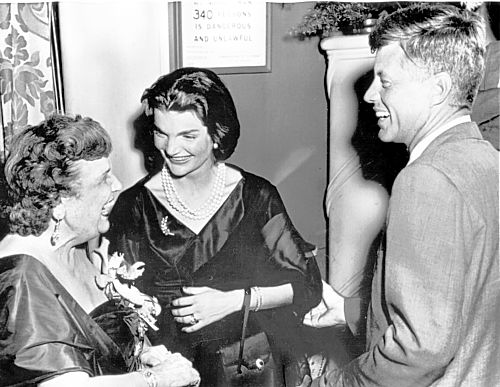
Jackie Kennedy and her husband U.S. Senator John F. Kennedy greeted by hostess Perle Mesta at a 1956 Democratic National Convention party she hosted.
Jacqueline Kennedy attended the 1956 Democratic National Convention in Chicago. With her hopes dashed that her husband, then a U.S. Senator, would be chosen as the vice-presidential candidate to nominee Adlai Stevenson, the event proved stressful and days later she was rushed to the hospital where she delivered a stillborn child.
Pregnant again four years later when her husband was nominated for the presidency, she remained at home, absent from the event.
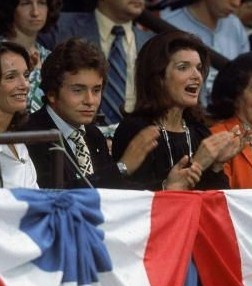
Jacklie Onassis at the 1976 Democratic National Convention.
Not until 1976, as the widow of not just President Kennedy but Aristotle Onassis did she attend a Democratic National Convention, which nominated Jimmy Carter and was held in her home town of New York City. Jacqueline Onassis also appeared at the one there in 1992, which nominated Bill Clinton. At none of them did she speak.
For another thirty-two years, no candidate’s wife addressed a national convention nominating her husband, until the 1972 Republican National Convention in Miami, which re-nominated incumbent President Richard Nixon.
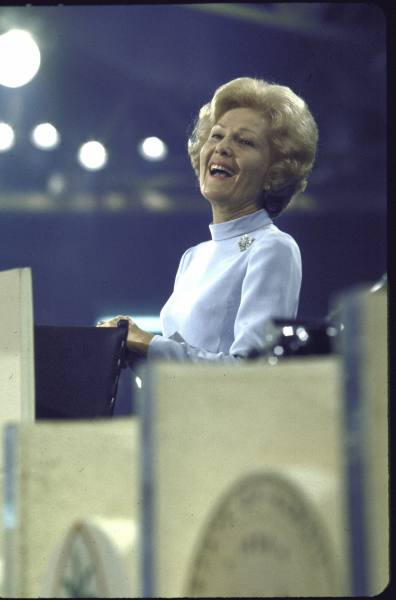
Pat Nixon addressing the 1972 Republican National Convention in Miami.
At that event, First Lady Pat Nixon became the first candidate’s spouse to be introduced by a convention film, a short biography reviewing her formidable record of domestic trips to a wide variety of citizen activist projects and global travel as an official ambassador.
Not unlike Michelle Obama, whose convention speech was also introduced with a short film biography, Pat Nixon had extreme ambivalence about her husband seeking the presidency in 1968.
As she had said during that campaign, “Everything I have ever cared about has been sacrificed for politics.” She also admitted in a vein quit similar to Michelle Obama that “Politics was not a life I would have chosen for myself..”
But after four years of being First Lady, with extensive travel around the nation – as well as the world, both with and without the President, she had grown to love her role on the public stage, not so much in terms of media attention but finding she had the power to help change individual lives. And numerous reporters, even many with a mistrustful grudge against her husband, attested to the fact that her genuine warmth, as shown through her spontaneous touching, hugging and patting – another attribute obvious in Mrs. Obama – was obviously natural and spontaneous. In this 1972 convention film bio of her is also a clip showing her asking that a border fence between the U.S. and Mexico be removed, so she could walk and meet Mexicans up-close:
For most of the nation, it was the first time they’d heard her speak and she admitted as much in what was intended as a message of appreciation for the years of volunteer service of many loyal Nixon campaigners but led to a nearly ten-minute standing ovation for her: “I don’t come out much from the wings, so this is quite unusual for me…I shall remember it always.”
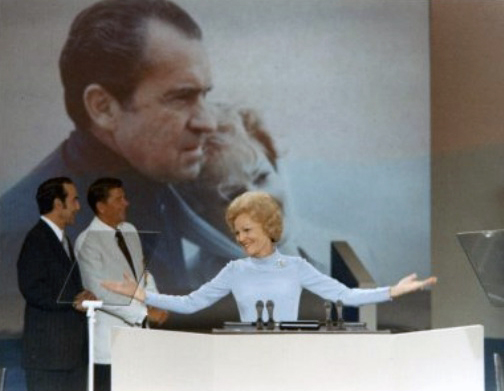
Pat Nixon was the second First Lady to address a national presidential convention, 1972. Bob Dole and Ronald Reagan stand behind her.
For a private person who had struggled to compromise her intense repulsion for politics with her dogged loyalty to her husband, it was an unexpected but deserved moment of recognition.

Nancy Reagan on the podium, her husband on the screen behind her.
Oddly, two of the most overtly political of candidates wives, both First Ladies, Betty Ford and Rosalynn Carter, never addressed their party conventions. It was not until 1984, when Ronald Reagan was re-nominated for a second term that another First Lady addressed a convention.
The year of Nancy Reagan’s appearance also eerily evoked the famous George Orwell novel about a future where “big brother” could see what everyone was doing: it was titled 1984.
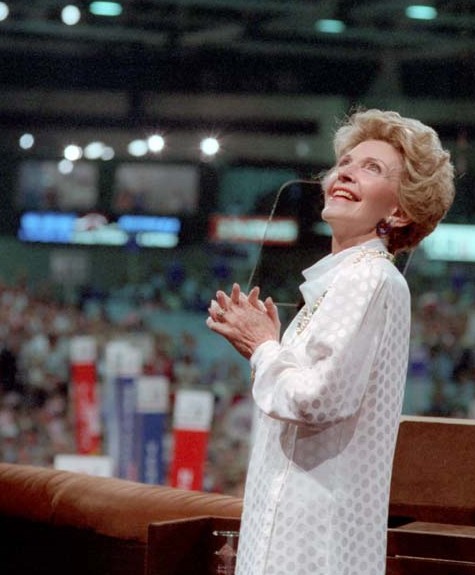
1984: Nancy Reagan turns from the podium to look at her husband on the screen.
As Mrs. Reagan spoke from the podium, on the gargantuan screen behind her, her husband suddenly appeared on it, being broadcast live from his hotel room where he was watching her. She turned around to wave at him, dwarfed by his giant face as he waved back.

Nancy Reagan speaking at the 1996 Republican Convention.
At the 1988 Republican National Convention in Houston which nominated Reagan’s Vice President George H. Bush for the presidency, the outgoing First Lady again addressed delegates, telling them “One era is ending and another is beginning.”
And like Eleanor Roosevelt whose 1940 convention speech she’d witnessed, Mrs. Reagan became the second former First Lady to address a convention, doing so during a tribute to her husband at the 1996 Republican National Convention in San Diego.

Barbara Bush speaking to delegates of the 1992 Republican National Convention.
Perhaps one of the most successful speeches made by a candidate’s spouse was one delivered by Barbara Bush to the 1992 Republican National Convention. Defying the sharply conservative tone of speakers attacking the Democratic candidate’s spouse, Hillary Clinton, Barbara Bush pointed out that her idea of Republicanism was inclusive, remarking, “”However you define family, that’s what we mean by family values.” Even more startling was her defining the need for “neighbors,” among others, to help raise children of parents with limited means and time: Barbara Bush ended up essentially characterizing the very same message that Hillary Clinton made with her book, It Takes A Village to Raise a Child and which Clinton would defend at the 1996 Democratic National Convention against attacks by that year’s nominee of the Republicans, Bob Dole.

This screen shot shows future First Lady Laura Bush behind her mother-in-law after the latter finished her 1992 convention speech.
As she finished her 1992 speech, Barbara Bush was joined on stage by her numerous grandchildren. Fourteen years later, two of them, the twin daughters of incumbent President George W. Bush, then being re-nominated, appeared on the Republican National Convention stage to introduce their mother Laura who then addressed the convention.
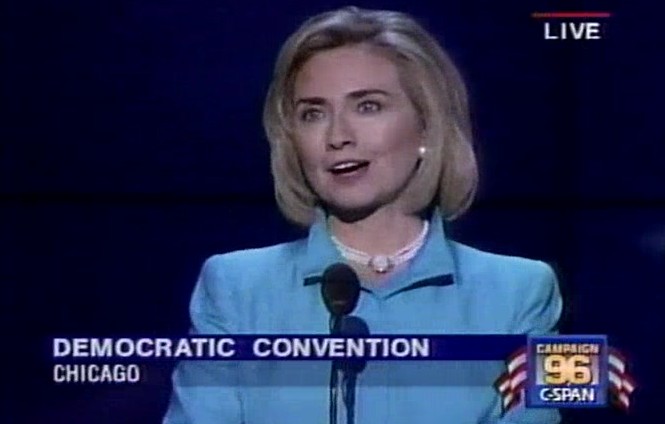
Incumbent First Lady Hillary Clinton gave a rousing speech to the 1996 Democratic National Convention which straddled both the personal and the political.
Amid her own candidacy for the United States Senate, Hillary Clinton addressed the Democratic National Convention a second time, at the event in Los Angeles in the year 2000. When she gave her 2004 speech she was, like Mrs. Roosevelt and Mrs. Reagan, a former First Lady. And, until just a month before her 2008 Democratic National Convention speech in Denver, she was herself- a former presidential candidate herself. Here is her 2008 speech, when she was introduced by her daughter Chelsea Clinton:
Her first such appearance was among the most anticipated at the 1996 Democratic National Convention which gave Bill Clinton his second term.
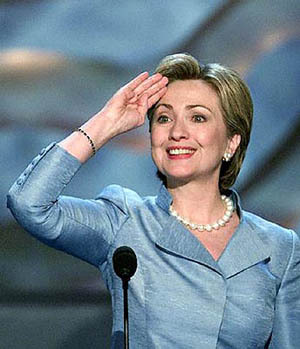
As outgoing First Lady and U.S. Senate candidate in 2000, Hillary Clinton made her second speech to the Democratic Convention.
After a tumultuous first term in which she was attacked for being overtly involved in presidential policy, she turned her expertise to great advantage, specifying pieces of legislation she had helped see through as part of her husband’s overall achievements.
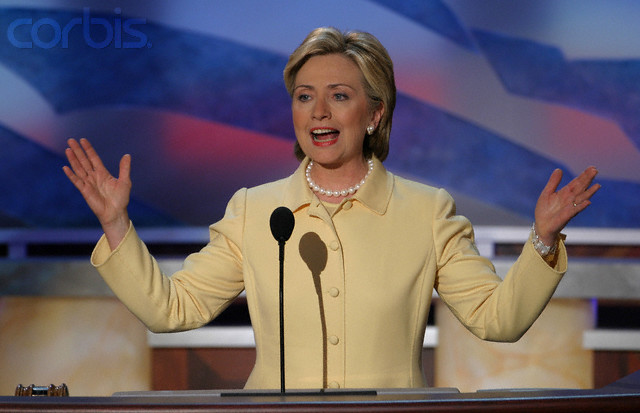
Mrs. Clinton addresses the 2004 Democratic Convention as a U.S. Senator.
She also defended the Clinton record against the Republican convention speech of candidate Bob Dole who used the title of her book It Takes a Village to Raise a Child, to frame a false argument that the Clintons sought to initiate government control of children.
In that 1996 Democratic National Convention speech, however, Hillary Clinton also delivered an eloquent turn of phrase which applied not only to those running for president, but for all people:
“One thing we know for sure is that change is certain. Progress is not. Progress depends on the choices we make today for tomorrow and on whether we meet our challenges and protect our values.”

A presidential candidate in her own right that year, Hillary Clinton addresses the 2008 Democratic National Convention.
Related articles
Related articles
- Michelle Obama to Make Case Husband Deserves a Second Term – Bloomberg (bloomberg.com)
- Bring It, Mobama! (thedailybeast.com)
- Conventions a time-honored tradition – GoDanRiver.com (godanriver.com)
- Watch Michelle Obama’s Speech at Democratic National Convention! (justjared.com)
- Michelle Obama’s message: The president is just like you (thegrio.com)
- First lady hails Obama’s values as Democratic speakers assail Romney (nbcpolitics.nbcnews.com)
- Michelle Obama’s Speech Brings In 28K Tweets Per Minute, Destroys Mitt Romney (techcrunch.com)
Categories: Barbara Bush, Eleanor Roosevelt, First Ladies, History, The Obamas
Tags: Ann Romney, Barack Obama, Barbara Bush, Eleanor Roosevelt, Hillary Clinton, Jacqueline Kennedy, Michelle Obama, Mitt Romney, Nancy Reagan, Pat Nixon
 Jackie & The Nixons: Mrs. Kennedy Returns to the White House, With New Images of the Visit
Jackie & The Nixons: Mrs. Kennedy Returns to the White House, With New Images of the Visit  Jane & Jill, Potential First Ladies: Lots in Common Between the Wives of Joe Biden & Bernie Sanders
Jane & Jill, Potential First Ladies: Lots in Common Between the Wives of Joe Biden & Bernie Sanders  Liz Taylor Meets Jackie Kennedy: Tabloid Fantasy to Chance Encounter & The Only Photos of Them Together, Part II
Liz Taylor Meets Jackie Kennedy: Tabloid Fantasy to Chance Encounter & The Only Photos of Them Together, Part II  Melania Trump v. John Kelly: First Ladies & West Wing Personnel, A Brief History
Melania Trump v. John Kelly: First Ladies & West Wing Personnel, A Brief History  Melania Trump’ Hospitalization: What the Public Is Told About a First Lady’s Health
Melania Trump’ Hospitalization: What the Public Is Told About a First Lady’s Health  “Yes, I am a Liberal,” Barbara Bush’s Politics: Gays, Guns & Equal Rights
“Yes, I am a Liberal,” Barbara Bush’s Politics: Gays, Guns & Equal Rights
Leave a Reply